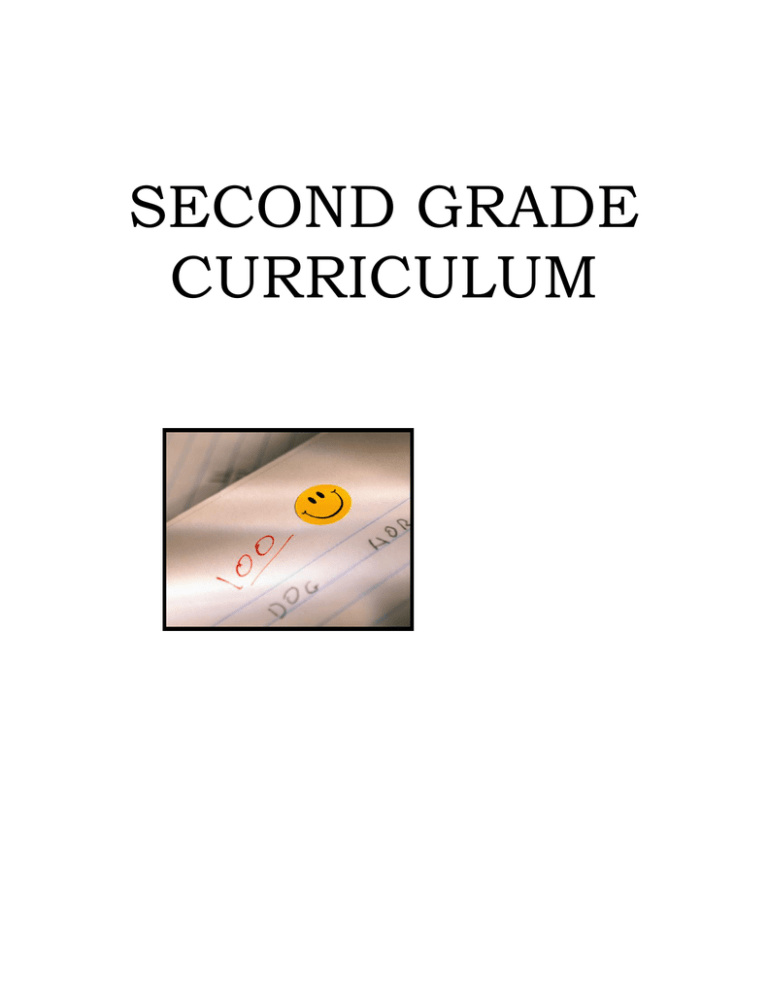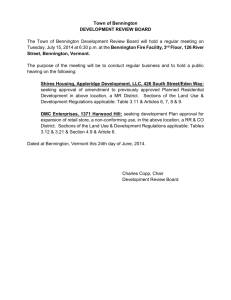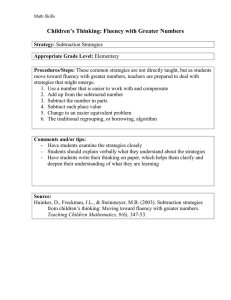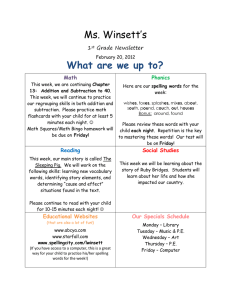READING - The reading curriculum is based upon state and locally
advertisement

SECOND GRADE CURRICULUM IN THIS CLASSROOM We believe that learning is a lifetime adventure. We believe in facing each day with minds open to knowledge and hearts open to love. We believe in the freedom to wonder, to ask, to explore, to imagine, to create. We believe that success means doing our best, being our best and feeling proud of our effort. We believe that every one of us has special talents, and that the talents of each of us help all of us. We believe in ourselves, in each other, IN THIS CLASSROOM by Jan Halyer Bennington Public Schools Language Arts Mission Statement Bennington Public Schools is committed to helping all students become successful readers, writers, listeners, and speakers. Students will be provided with reading skills based on both the structure of language and the meaning of language in context that they can apply. Bennington students will become independent readers, writers, listeners, and speakers through a balanced literacy instructional program. Bennington’s balanced literacy program will consist of: systematic & explicit instruction in: o phonemic awareness o phonics o fluency o vocabulary o comprehension of both factual & fictional material reading aloud both student & teacher shared reading guided reading in flexible groups independent reading instruction in the Six-Trait Writing + 1 Model o voice o ideas o word choice o organization o fluency o conventions o presentation modeled and shared writing interactive writing independent writing speaking instruction & opportunities listening instruction & opportunities SECOND GRADE CURRICULUM GUIDE READING – In reading we will be using the McGraw-Hill Reading Wonders series called Unlock the Wonders of Reading. Reading Wonders is designed specifically for the State Standards for Reading/Language Arts. Combining research-based instruction with new tools to meet today's challenges, every component and every lesson is designed for effective and efficient instruction. The program provides support for Building a strong reading foundation Accessing complex text Finding and using text evidence Engaging in collaborative conversations Writing to sources Using a rich range of diverse print and digital media, Wonders provides the instructional support and materials that were created to teach the rigor, intent, and depth of the new State Standards. READER’S THEATER - This is an important piece of our reading curriculum, as it develops fluency, public speaking experience, and reading with expression. Poetry reading will be included with our Reader’s Theater. SPELLING - Bennington has adopted the Sitton Spelling series. The students’ instruction will focus on spelling patterns, writing application, and word analysis. There is not a weekly spelling list. Instead, the students are required to master the Level 2 Core Words (see attached) by the end of the year. These words will be recycled periodically throughout the year to help your child become a proficient speller. Assessment will take place at the end of each unit. The units are approximately 7-10 days. The students’ “spelling words” will be presented in the context of a story. After the test, words missed will be placed on a “words to learn list” for home study. WRITING - We will be doing a variety of writing in the classroom throughout the year. Our writing curriculum, from Scholastic, is based upon the Six +1 Traits of writing, which are the foundational skills needed to be proficient writers across the curriculum. Areas of emphasis will consist of Ideas, Word Choice, Sentence Fluency, Voice, Organization, Conventions, and Presentation in pieces that are created following an accurate writing process, using children’s literature as a guide. HANDWRITING - The students will be practicing Zaner-Bloser manuscript. This will be done in their daily work. Please see attached for a model. MATH - The math curriculum is based upon state and locally approved standards for student learning. We use the Scott-Foresman Envision Math series which incorporates a variety of activities using writing, literature, manipulatives, and problem solving. Students still need to learn their basic addition and subtraction facts. There will be weekly addition and subtraction timed tests. The skills covered in math are on the attached list. SCIENCE – Our district has adopted the Science Fusion curriculum from Harcourt. It is based upon state and locally approved standards for student learning, as with all subject areas. We will be covering Life Science topics such as plants and animals; Earth Science topics such as features of the earth and its resources and weather patterns; and will study the solar system and some various astronomy aspects. SOCIAL STUDIES - The emphasis in our social studies curriculum includes the study of community, mapping skills, cultural awareness, government, and observances of various holidays. Our lessons are derived from the Scott Foresman series. Additional topics may include: upcoming elections, Holidays Around the World, Martin Luther King Jr., and President’s Day. GUIDANCE - Once a week, our elementary guidance counselor will come to the classroom. The curriculum our district uses for our guidance program is through the Mendez Foundation. In the fall we do a program entitled Too Good for Violence, and in the spring we do Too Good for Drugs. Topics such as drugs, alcohol, tobacco, bullying, and peer pressure are covered. In addition, we learn about creating a healthy lifestyle through friendship, effective communication, self-care, and managing emotions. We teach these subjects through role-plays, games, and activities. Supplemental topics beyond our Mendez curriculum are also studied such as career exploration, academic success, empathy/self-esteem, safety and stranger danger. In addition to classroom guidance instruction, our counselor is available to work with individual students and small groups. Groups are available for topics such as learning social skills, making friends, coping with grief/loss and adjusting to divorce/separation. PHYSICAL EDUCATION - The primary purpose of the physical education program is to provide students with the opportunities to gain the knowledge, understanding, and skills to practice healthy physical activities throughout their lives. All students are taught to work together and treat others with respect and good sportsmanship. MUSIC - The Mission of Bennington’s Music Department is to engage students in the study of music, giving them the opportunity to be creative in an environment that fosters self-expression, teamwork and cultural diversity. nd 2 Grade Rhythm Identification of 2/4 4/4 Measure/Bar line Melody/Pitch Skips, steps, repeats S-M-L-D-R Echo singing, signing, and playing Form Rondo Interlude Repeat Sign Round/Canon Verse, refrain 2 ostinati 2 measure ostinati 2 part speech and singing Broken Bordun Octave Bordun Do Pentatonic Major/minor Texture/ Harmony Expression Loud/soft Crescendo/decrescendo History/Style/ Timbre Folk song repertoire Singing games Nursery rhymes Program music Classroom instruments Multicultural songs ART - The elementary art curriculum encompasses the Art Elements and Design Principles in a comprehensive art education model and uses the National Art Standards. Focus Unit 1: Unit 2: Unit 3: Unit 4: Unit 5: Unit 6: Line and Shape Space and Form Color Texture, Pattern and Rhythm Space, Proportion and Distortion Balance, Variety, Unity and Harmony Elements Line – Sketch Color – Monochromatic Shape – Two Dimensional Value – Tints & Shades Space – Background, Foreground, & Middle ground Positive & Negative Space Form – Three Dimensional Principles Proportion – Knee’s & Elbows Balance – Radial Balance Contrast – Shape Contrast Unity/Variety – A Cohesive Unit SPANISH SECOND GRADE UNIT 1 Numbers 1-30 UNIT 2 School supplies UNIT 3 Family members *Students will receive a “Spanish Squares” sheet at the beginning of each unit. It consists of 5 tasks or skills the students are to master by the end of the unit. Students are asked to practice the skills every day at home and return the individual Squares signed, when they have mastered the task/skill. Parent involvement, support and, encouragement in this process not only increases student acquisition of Spanish but also gives students an increased sense of confidence. *Please access our Spanish website for vocabulary lists, copies of assignments, and copies of the Spanish Squares. The website also has additional practice for students. WEBSITE ADDRESS:http://bennington.ishareinfo.org/kadeshina/index.cfm TECHNOLOGY Skills mastered at Second Grade Identify computer parts using correct terms Show proper care of equipment Navigate through instructional software and launch new programs Use cursor; enter key, backspace and arrow keys Use thumb on space bar Show proper position of mouse to point and click Use multimedia resources Use common network courtesies such as using your own password Use simple graphics in class stories HOMEWORK - Students will be given homework throughout the week. The student is required to have his or her homework returned the next day completed. Reader’s Theater scripts are also considered homework items when sent. Please check your student’s homework folder each night to review enclosed materials. Homework policies may vary from classroom to classroom. Three or more missing/late/incomplete assignments result in a detention. Each child will have a daily assignment planner. The planner will be completed at school for aid in completing necessary homework elements nightly at home which are to be returned the following morning. DISCIPLINE POLICY - Our discipline policy focuses on prevention. By creating a positive environment with clear expectations, we hope to eliminate potential conflicts. Each room has a slightly different variation of discipline based upon the Bennington Public Schools core DWP skills. Students are part of the establishment of their own classroom rules and expectations are clearly defined. SEMESTER MILK – Second graders have either a morning or afternoon milk break. Students are able to purchase milk from the school. See student handbook for more details. PORTFOLIOS - Your student will receive a portfolio in lieu of a report card. You will have an opportunity to view your students’ portfolio at each of the conference times and then be able to keep it at the end of the year. The portfolio will show the growth of your student from the beginning of the year to the end of the year. Each student will also be presented with a SIMS report indicating the child’s scores for the district assessments taken throughout the year. It is not a report card, but it will be presented to give parents a deeper understanding of student progression on the core standards throughout the year. ASSESSMENT OF LEARNING - The school system assesses students according to procedures in its local assessment plan which meets the assessment requirements specified by the Nebraska Department of Education’s Rule 10: Regulations and Procedures for the Accreditation of Schools. Our students are assessed on the following tests: CRITERION-REFERENCED: These are given in the subject areas of reading, language arts, science, and math. They are administered throughout the school year. TERRA NOVA CTBS: This standardized achievement test is administered to second graders in the fall, typically in the month of October. Second Grade Basic Math Skills ADDITION Fact families Addition doubles Addition strategies Adding single digits up to sums of 20 Add 3, 1 digit numbers Add 2 digit numbers with and without regrouping Add 3 digit numbers with and without regrouping Problem solving using addition SUBTRACTION Subtraction strategies Subtract single digit from up to 20 Subtract 2 digit numbers with and without regrouping Subtract 3 digit numbers with and without regrouping Problem solving using subtraction PLACE VALUE Place value from 0 – 1000 NUMBERS Read and write numbers from 0 – 1000 Using greater than and less than Round numbers up to 1000 to the nearest named place Ordinal numbers through 20th Count and write by 2’s, 3’s, 4’s, 5’s, and 10’s MONEY Identify and count money amounts up to $10 Identify and use least amounts of coins TIME Tell time to hour, ½ hour, 15 minute, and 5 minute Retrieve information from a calendar DATA AND GRAPHS Bar graphs Pictographs Tally graphs MEASUREMENT Use nonstandard units to measure Measure using centimeters and meters Measure using inches, feet, and yards FRACTIONS Identify fractions ALGEBRAIC CONCEPTS Identify and describe patterns GEOMETRY 2 and 3 dimensional geometric shapes Understand congruence Draw and discuss symmetrical shapes


